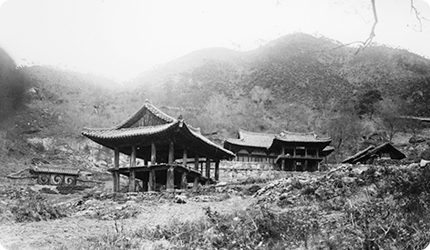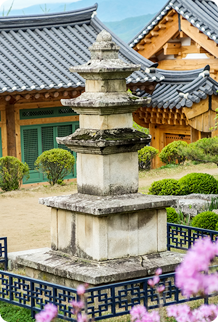Buddhist Mountain Monasteries in Korea
Buseoksa Temple
Buseoksa Temple
Introduction
Natural Environment
History
Temple Layout
Cultural Properties
Information
History of Buseoksa Temple
-
- Buseoksa was founded by Great Monk Uisang in 676 (16th year of King Munmu’s reign) in the Silla period.
In regard to the founding of the temple, Samguk-sagi (The Chronicles of Korea's Three Kingdoms) states that “Buseoksa was founded by venerable priest Uisang under the instructions of the king,” while Samguk-yusa (Legends and History of Korea’s Three Kingdoms) states, “Uisang went to Taebaeksan Mountain and founded Buseoksa and propagated Buddhism to honor the king’s wishes.”
At the time of its foundation, the temple was probably not as large as it is today. In addition to Samguk-sagi and Samguk-yusa, the history of Buseoksa is described in Bonghwangsan-Buseoksa-Gaeyeongi, Buseoksa-Anyangnu-Jungchanggi, Wonyongguksatapbi and other documents written in ink. -
 Buseoksa Temple during the Japanese occupational period
Buseoksa Temple during the Japanese occupational period
- Buseoksa was founded by Great Monk Uisang in 676 (16th year of King Munmu’s reign) in the Silla period.
In regard to the founding of the temple, Samguk-sagi (The Chronicles of Korea's Three Kingdoms) states that “Buseoksa was founded by venerable priest Uisang under the instructions of the king,” while Samguk-yusa (Legends and History of Korea’s Three Kingdoms) states, “Uisang went to Taebaeksan Mountain and founded Buseoksa and propagated Buddhism to honor the king’s wishes.”
-
-
 Three-Story Stone Pagoda of Buseoksa Temple
Three-Story Stone Pagoda of Buseoksa Temple
- Immediately after the founding of the temple, Great Monk Uisang held assemblies for 40 days and gave talks on the Flower Garland sutra. This enabled Buseoksa to become the Bodhi-mandala of Silla Flower Garland Sect.
People called Uisang “Buseokjonja (Sage of Buseok)” and his Flower Garland Sect “Buseok-jong,” which attests to the prestige and status of Buseoksa.
Also, Great Monk Uisang had about 3,000 disciples, who were all taught at Buseoksa Temple.
Of the disciples, those who resided at Buseoksa Temple and developed the Flower Garland Sect include Hyecheol, who founded Dongnisan-pa as well as Muyeom and Jeoljung.
In the early Goryeo Dynasty, National Preceptor Wonyung conducted a large rebuilding project, and imprinted the Tripitaka printing blocks, which partially remain to this day. National Preceptor Wonyung spent his entire life at Buseoksa, and after he entered Nirvana, a monument dedicated to him was erected at the temple. Then, in 1101 (6th year of King Sukjong’s reign), under King’s orders, a monument recognizing the good deeds and achievements of Great Monk UIsang was erected. In 1358 (7th year of King Gongmin’s reign), some of the temple buildings and structures were destroyed due to plundering by the Japanese. In 1376 (2nd year of King Wu’s reign), National Preceptor Woneung Cheonhui repaired Muryangsujeon and Josadang. In the Goryeo Dynasty, the temple was also called Seondalsa or Heunggyosa. Seondal, which sounds similar to “Seondol,” is believed to be another notation for “Buseok,” while Heunggyo probably refers to the revival of the Flower Garland Sect.
-
- In the Joseon Dynasty, Buddhism was oppressed under state policy, but the lamp of Dharma (Buddha’s teachings) continued to be passed on at Buseoksa. Large-scale rebuilding work performed at Buseoksa including the reconstruction project of Great Monk Samyeong in 1580 and the restoration work performed in 1748 to rebuild the halls and shrines that had been destroyed by fire in 1746. In modern history, Muryangsujeon and Josadang were deconstructed and repaired in 1916. This was around the time when Chwiwonnu, which had been situated on the west of Muryangsujeon, was moved to the east side, and its name was changed to Chwihyeonam. In 1967, the twin pagoda on the old temple site was moved to the front of Beomjonggak Bell Tower. After 1977, Iljumun, Cheonwangmun and Sundang were erected one by one, and in 1980, Iljumun and Eunghyanggak were newly constructed.
Chronological Table
| Time Period | Description |
|---|---|
| 676 | Buseoksa Temple is founded by Great Monk Uisang |
| Goryeo Dynasty | National Preceptor Wonyung (964-1053) rebuilds the temple and imprints the Tripitaka printing block |
| 1101 | Uisang-daesa-gongdeokbi (a monument honoring the contributions of Great Monk Uisang) is erected |
| 1201 | Dancheong work is performed on Josadang Shrine |
| 1250 | National Preceptor Chongmyeong Gageung typesets the Amitabha sutra to be housed in Panjeon Hall |
| 1358 | Part of the temple is destroyed during Japanese invasion (Muryangsojeon Hall is destroyed) |
| 1376 | Muryangsujeon Hall is reconstructed by National Preceptor Woneung |
| 1555 | A fire occurs at Buseoksa |
| 1580 | Reconstruction work is initated by Great Monk Samyeong |
| 1613 | Chwihyeonam hermitage is reconstructed |
| 1723 | Anyangmun Gate is restored |
| 1746 | Temple halls and living quarters are substantially destroyed by fire |
| 1748 | Seungdang, Manwoldang, Seobyeolsil, Manseru and Beomjonggak are restored |
| 1916 | Muryangsujeon, Eumhyanggak and Josadang buildings are repaired, and Chwihyeonam is relocated |
| 1967 | Ssangtap (Twin Pagodas) are relocated from the old temple site in the east to the site in front of Beomjonggak |
